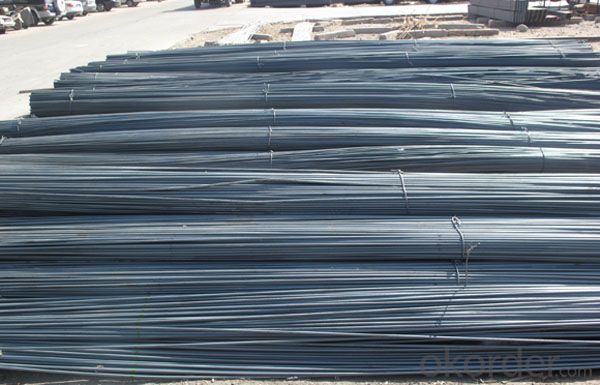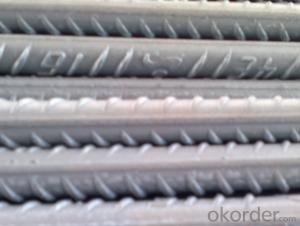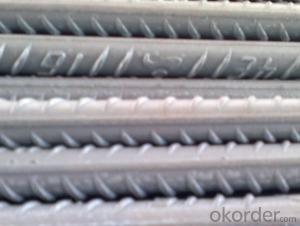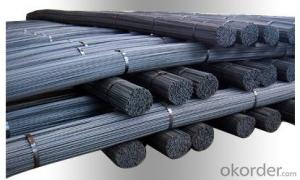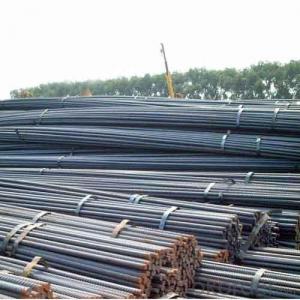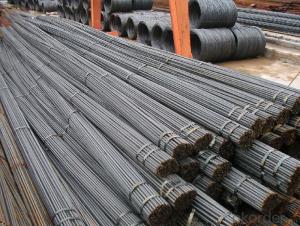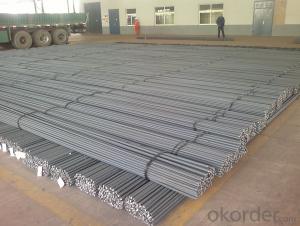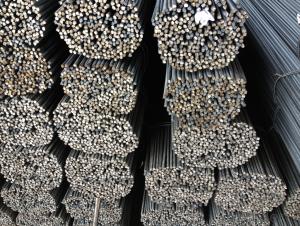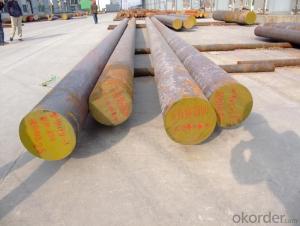Steel Rebar,Deformed Steel Bar,Iron Rods For Construction/Concrete
- Loading Port:
- Shanghai
- Payment Terms:
- TT OR LC
- Min Order Qty:
- 100 m.t.
- Supply Capability:
- 1000 m.t./month
OKorder Service Pledge
OKorder Financial Service
You Might Also Like
deformed steel bar grade 40
material: HRB400, BS4449 GR460B
size: 8-36mmx12m.
short delivery time by bulk or container
deformed steel bar grade 40
material: HRB400, BS4449 GR460B
size: 8-36mmx12m.
short delivery time with bulk or container
packing: Mill standard export packing in bundles/coil, around 2tons/bundle.
country of Origin: China
delivery Time: Within a 35 days
Shipment: by bulk vessel or by container
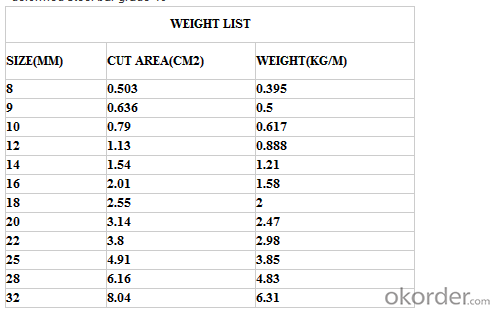
Leading goods:
section steel:angles,channels,I-beam,H-beam;
coils:cold/hot rolled coils,PPGI,galvanized coils,plate,checkered plate,cutting steel plate,steel strip;
wire rod:steel wire,deformed wire,bar;
pipe:seamless pipe,rectangular pipe,welded pipe,spiral welded pipe,pipe fittings;
stainless steel:steel sheets,stainless steel strips,stainless bar,stainless tube;
special:weathering steel,shipbuilding steel;
construction steel:C-channel,Z-channel,T-bar,high-speed divider plate,corrugated steel plate,steel grating.
Advantage:
We are the spot supplier, Six huge warehouses which can hold 20,000 MT goods.
It makes the cost lower than others,we can provide the competitive price for you.
Delivery time:
Normal sizes can be provided in 7days, the others should be ready in 30---45 days.
Further treatment:
We can offer cutting,painting,drilling holes,bending,threading, welding,galvanization,packing etc.
Security interest:
We have already passed the ISO9001, BV and SGS authentication which makes the quality secured.
If you have the interest in any of the products we can provided, pls don't hesitate to connect with me. Looking forward to cooperate with you.

FAQ of Steel Deformed Bar
1. More than 10 years experience in this industry
2. 100,000 tons exporting per month
3. Professional foreign trade tea
4. OEM&ODM capacity
5. High quality assured & competitive price
6. Try our best to meet your needs & save your budget
7. Very popular in Southeast Asia, Africa, Mid-East and South America etc.
8. VIP membership system, first time customers and long-term cooperation customers can get extra discount on some products.
- Q: How do steel rebars contribute to the overall durability and service life of concrete structures?
- Concrete structures benefit from the inclusion of steel rebars in several ways, contributing to their overall durability and service life. To begin with, steel rebars are utilized in concrete structures to bolster their tensile strength. While concrete is strong under compression, it lacks strength when subjected to tension. Incorporating steel rebars, which possess high tensile strength, into the concrete significantly increases the overall strength and load-bearing capacity of the structure. This enables the structure to withstand external forces such as wind, earthquakes, or heavy loads, thereby reducing the risk of structural failure and enhancing its overall durability. Additionally, steel rebars play a vital role in preventing cracking and controlling the spread of cracks within concrete structures. As concrete dries and undergoes temperature fluctuations, it has a tendency to shrink and crack. The presence of steel rebars helps to distribute these forces and stresses throughout the structure, minimizing the formation and expansion of cracks. By restricting the propagation of cracks, the rebars contribute to the overall structural integrity and longevity of the concrete structure. Moreover, steel rebars offer reinforcement against corrosion. Concrete possesses high alkalinity, which generates a protective layer known as the passivation layer around the steel rebars. This layer safeguards the rebars from rusting and corroding when exposed to moisture or aggressive chemicals. By preserving the integrity of the rebars, the overall durability and service life of the concrete structure are enhanced. Furthermore, steel rebars are instrumental in improving the structural stability and resilience of concrete structures. By providing reinforcement and rigidity to the concrete, they aid in the even distribution and dissipation of applied loads and stresses. This diminishes the likelihood of localized failure and augments the structure's capability to withstand external forces and deformations. The presence of steel rebars also enhances the structural behavior of the concrete, rendering it more resilient to dynamic forces such as vibrations or impacts. In conclusion, steel rebars make a significant contribution to the overall durability and service life of concrete structures. They enhance the tensile strength of the concrete, prevent cracking and control the propagation of cracks, provide reinforcement against corrosion, and improve structural stability and resilience. By integrating steel rebars into concrete construction, engineers can create robust and long-lasting structures capable of withstanding various challenges, ensuring the safety and longevity of the built environment.
- Q: How do steel rebars contribute to the overall aesthetics of a structure?
- Steel rebars do not directly contribute to the overall aesthetics of a structure as they are typically hidden within the concrete. However, their use ensures structural integrity and strength, which indirectly enhances the overall appearance by providing a solid foundation for the design elements and finishes of the structure.
- Q: Can steel rebars be used in wastewater storage tanks?
- Indeed, wastewater storage tanks can utilize steel rebars. These rebars are frequently employed as reinforcement in concrete structures, including wastewater storage tanks. By imparting tensile strength to the concrete, the rebars enhance its resistance to cracking and bolster the overall structural integrity of the tank. Moreover, steel rebars possess corrosion-resistant properties, a crucial attribute given the inevitable exposure to corrosive elements in wastewater storage tanks. Consequently, the utilization of steel rebars in these tanks is a prevalent and efficacious practice within the construction industry.
- Q: Can steel rebars be used in concrete columns?
- Concrete columns can indeed incorporate steel rebars. In fact, it is a prevalent practice in the construction industry to reinforce concrete structures, including columns, with steel rebars. By embedding the rebars within the concrete mixture, the columns gain increased strength and durability. The primary purpose of incorporating rebars in concrete columns is to enhance their ability to withstand tension. Adding this additional tensile strength prevents the columns from cracking or failing when subjected to various loads and forces. The utilization of steel rebars in concrete columns is widely recognized and considered vital for maintaining the structural integrity and long-term viability of the columns.
- Q: What are the properties of steel rebars?
- Steel rebars, also known as steel reinforcing bars, possess several important properties. Firstly, they have high tensile strength, making them capable of withstanding heavy loads and stresses without breaking or bending easily. Secondly, they have excellent durability and resistance to corrosion, which ensures their long-term structural integrity. Moreover, steel rebars exhibit good thermal conductivity, allowing them to dissipate heat efficiently in high-temperature environments. Additionally, they are malleable and can be easily bent or shaped to fit different construction needs. Lastly, steel rebars have excellent bond strength with concrete, enabling the efficient transfer of loads between the two materials in reinforced concrete structures.
- Q: How do steel rebars affect the overall seismic performance of a structure?
- Steel rebars play a crucial role in improving the overall seismic performance of a structure. By reinforcing concrete elements, such as beams, columns, and slabs, rebars enhance the structural integrity and ductility of the building. This means that during an earthquake, the rebars help the structure withstand the lateral forces and deformations, minimizing the risk of collapse. Additionally, the presence of rebars improves the energy dissipation capacity of the structure, allowing it to absorb and dissipate seismic energy, further enhancing its resilience.
- Q: What is the fatigue strength of steel rebars?
- The fatigue strength of steel rebars refers to their ability to withstand repeated loading and unloading cycles without experiencing failure or fatigue crack propagation. This strength can vary depending on factors such as the specific grade of steel, rebar size and shape, surface condition, and loading conditions. Generally, steel rebars have high fatigue strength due to their inherent toughness and ductility, making them suitable for applications in construction projects where cyclic loading is common, such as bridges, highways, and buildings.
- Q: Why can't grounding steel be used?
- When the thread steel is grounded, the contact with the soil is not dense, and the grounding resistance value is increased
- Q: Can steel rebars be used in structures with heavy dynamic loads?
- Structures with heavy dynamic loads can indeed make use of steel rebars. In reinforced concrete structures, steel rebars are commonly employed to enhance tensile strength and improve overall structural integrity. Their specific design enables them to withstand heavy loads, including dynamic ones caused by vibrations, earthquakes, or moving vehicles. The remarkable tensile strength of steel rebars allows for effective absorption and distribution of dynamic loads, effectively preventing structural failure or collapse. Moreover, steel rebars exhibit exceptional resistance to fatigue, thereby maintaining their strength and integrity even under repeated loading and unloading cycles. To ensure optimal performance under heavy dynamic loads, engineers take into account various factors, such as the size, shape, and spacing of rebars, as well as the quality of the concrete and the design of the structure itself. By meticulously designing and reinforcing the structure with steel rebars, it becomes possible to create a building that is both safe and durable, capable of withstanding heavy dynamic loads.
- Q: What are the potential risks of using steel rebars in construction?
- Some potential risks of using steel rebars in construction include corrosion, inadequate bonding with concrete, and potential for structural failure if not properly installed or maintained. Additionally, steel rebars can conduct electricity, posing a risk in areas with electrical currents or lightning storms.
Send your message to us
Steel Rebar,Deformed Steel Bar,Iron Rods For Construction/Concrete
- Loading Port:
- Shanghai
- Payment Terms:
- TT OR LC
- Min Order Qty:
- 100 m.t.
- Supply Capability:
- 1000 m.t./month
OKorder Service Pledge
OKorder Financial Service
Similar products
Hot products
Hot Searches
Related keywords



